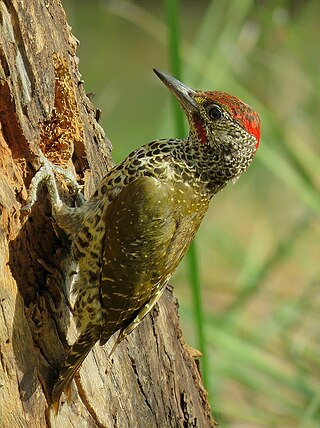
Zygiella x-notata, sometimes known as the missing sector orb weaver or the silver-sided sector spider, is a spider species in the family Araneidae. They are solitary spiders, residing in daily spun orb webs. Z. x-notata is a member of the genus Zygiella, the orb-weaving spiders. The adult female is easily recognized by the characteristic leaf-like mark on her posterior opisthosoma, caudal to the yellow-brown cephalothorax.

The yellow-spotted honeyeater is a species of bird in the family Meliphagidae. It is also known as the lesser lewin. The bird is endemic to northern Queensland. The bird's common name refers to the yellow patch that members of the species have behind their eyes.

The Knysna woodpecker is a species of bird in the family Picidae. It is endemic to South Africa, where its natural habitats are subtropical or tropical moist lowland forests, moist savanna, and subtropical or tropical moist shrubland. It is threatened by habitat loss. It belongs to a species complex that includes the golden-tailed and Mombasa woodpeckers.

Macaria notata, the peacock moth, is a moth of the family Geometridae. It is a Holarctic species.
Notata is a genus of moths in the subfamily Arctiinae.
Microsynodontis notata is a species of upside-down catfish endemic to Gabon where it occurs in the Ogowe River. It was first described in 2004 by Ng Heok Hee.

Euxesta notata is a species of ulidiid or picture-winged fly in the genus Euxesta of the family Ulidiidae. It is found in Canada. As a larva it is referred to as the spotted root maggot, and has evolved genetic resistance against DDT.

Oberea is a genus of longhorn beetles, most of which are stem borers of various plants, including blackberries and their relatives.

Glyceria notata, the plicate sweet-grass or marked glyceria, is an invasive specie part of the Poaceae family. tufted, perennial grasses in the mannagrass genus, found in all continents of the world. Its culms are 30–80 cm in height, ascending from a prostrate base, with dark- to bluish-green, flat or folded leaf-blades some 5–30 cm long by 3–14 mm wide.
Oberea affinis is a species of longhorn beetle in the tribe Saperdini in the genus Oberea, discovered by Leng & Hamilton in 1896.
Oberea consentanea is a species of beetle in the family Cerambycidae. It was described by Francis Polkinghorne Pascoe in 1867. It is known from Borneo.
Oberea rubetra is a species of beetle in the family Cerambycidae. It was described by Francis Polkinghorne Pascoe in 1858. It is known from Sumatra, Borneo and Malaysia.
Oberea neavei is a species of beetle in the family Cerambycidae. It was described by Per Olof Christopher Aurivillius in 1914.
Oberea erythrostoma is a species of beetle in the family Cerambycidae. It was described by Heller in 1915. It is known from the Philippines.
Oberea ferruginea is a species of beetle in the family Cerambycidae. It was described by Thunberg in 1787.

Oberea linearis is a species of beetle in the family Cerambycidae. It was described by Carl Linnaeus in 1761, originally under the genus Cerambyx. It has a wide distribution throughout Europe. It is preyed upon by Opilo pallidus, and serves as a host for the parasitic wasp species Dolichomitus messor and Phaenolobus terebrator. It feeds on Juglans regia, Corylus avellana, Ulmus glabra, Ostrya carpinifolia, and Carpinus betulus. It contains the varietas Oberea linearis var. parallela.
Oberea nigriventris is a species of beetle in the family Cerambycidae. It was described by Henry Walter Bates in 1873. It is known from Malaysia, Japan, Laos, Vietnam, China, Myanmar, and Taiwan.

The Colorado Desert fringe-toed lizard is a species of medium-sized, diurnal lizard in the family Phrynosomatidae. It is adapted to arid climates and is most commonly found in sand dunes within the Colorado Desert of the United States and Mexico.








